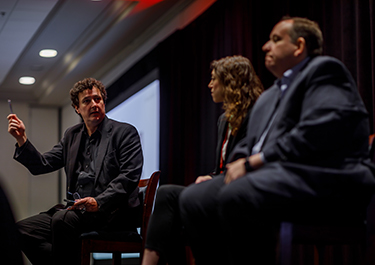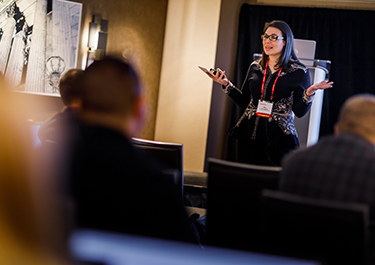 The CompTIA Communities and Councils Forum (CCF) hit Chicago this week; kicking off with a focus session titled Getting Over the Future Gap; a panel discussion led by CompTIA’s Chief Technology Evangelist James Stanger. The speakers tackled the future gap; the space between the amazingly convenient future that science fiction has long promised us and where we are today. The talk tied in directly with the cover story of CompTIAWorld issue five, which debuted at CCF and was authored by Stanger himself.
The CompTIA Communities and Councils Forum (CCF) hit Chicago this week; kicking off with a focus session titled Getting Over the Future Gap; a panel discussion led by CompTIA’s Chief Technology Evangelist James Stanger. The speakers tackled the future gap; the space between the amazingly convenient future that science fiction has long promised us and where we are today. The talk tied in directly with the cover story of CompTIAWorld issue five, which debuted at CCF and was authored by Stanger himself.
Stanger began his remarks by polling the audience about their favorite science fiction movies. Interestingly, attendees immediately shouted out The Empire Strikes Back and Star Trek, both of which are mentioned and depicted in illustrations in Stanger’s article in CompTIAWorld. The issue’s cover, meanwhile, is a reference to the 1982 film Blade Runner, which depicts a world of flying cars and 3-D scanners so sophisticated they can see into a printed photograph as if they’re actually walking into a room. Most importantly, the film features bioengineered androids called replicants; some so advanced in their artificial intelligence (AI) they don’t know they’re androids. They think they’re human, when they’re really “more human than human.”
The movie is set in the year 2019. So, now.
With some amusement at this, Stanger asked, “Are we there yet?” An audience member shot back, “Kind of.”
So, what’s holding us back? Stanger pointed to technical limitations; a lack of universal standards; a fear of being displaced by machines; skills gaps; and future fatigue. But he was quick to point out there are “terrific things” being made possible by tech today, such as smart cities; better emission controls; analytics-driven services with better reporting; traffic rerouting that saves our natural resources; and more.
Stanger’s panelists were Maddy Martin with Smith.ai and David Tan with CrushBank.
Touching on the future gap, Martin described developing a real time Spanish-to-English translator, which means Star Trek’s universal translator isn’t far from becoming a reality. She said the product is particularly useful for any immigration law firm.
Earlier, Stanger had made the point that AI won’t take away people’s jobs but rather the repetitiveness within jobs, something Martin agreed with. “Getting rid of tasks that are not stimulating is making better use of the human mind,” she said. “When basic functioning is covered, higher level functioning is accessed.”
Riffing on this, Stanger said, “People don’t get Ph.D.s if they don’t know where their next paycheck is coming from. Well, except I did.”
Asked to define AI, Tan described it as “any time you make a computer mimic human behavior.”
He addressed some misunderstandings about AI, particularly in how people react to his product. “They say, ‘That’s Skynet,’” a reference to the Terminator franchise’s computer program that destroys humanity. Tan, understandably, disagrees. “Maybe I’m naïve but I don’t see a future where machines are ever aware.”
Tan said there is some dishonesty surrounding how AI is used, particularly when it comes to chatbots. “Not all companies are up front about how you’re not talking to a human being,” he said. But he insisted that companies are not using cell phones to monitor people and target them with advertising. “Absolutely not,” he said. “Your phones are not listening to you.” Some would disagree.
Addressing such worries about technology, Martin said, “Whenever there’s new technology there are benefits and burdens that need to be assessed.”
Harrison Ford’s character Deckard says almost exactly the same thing in Blade Runner: “Replicants are like any other machine. They’re either a benefit or a hazard. If they’re a benefit, it’s not my problem.”
Click here to get a run-down on CCF's various community meetings.
Click here to learn more about the meeting.
Click here to learn more about the future gap and here to read CompTIAWorld issue five.

 Add CompTIA to your favorite RSS reader
Add CompTIA to your favorite RSS reader

